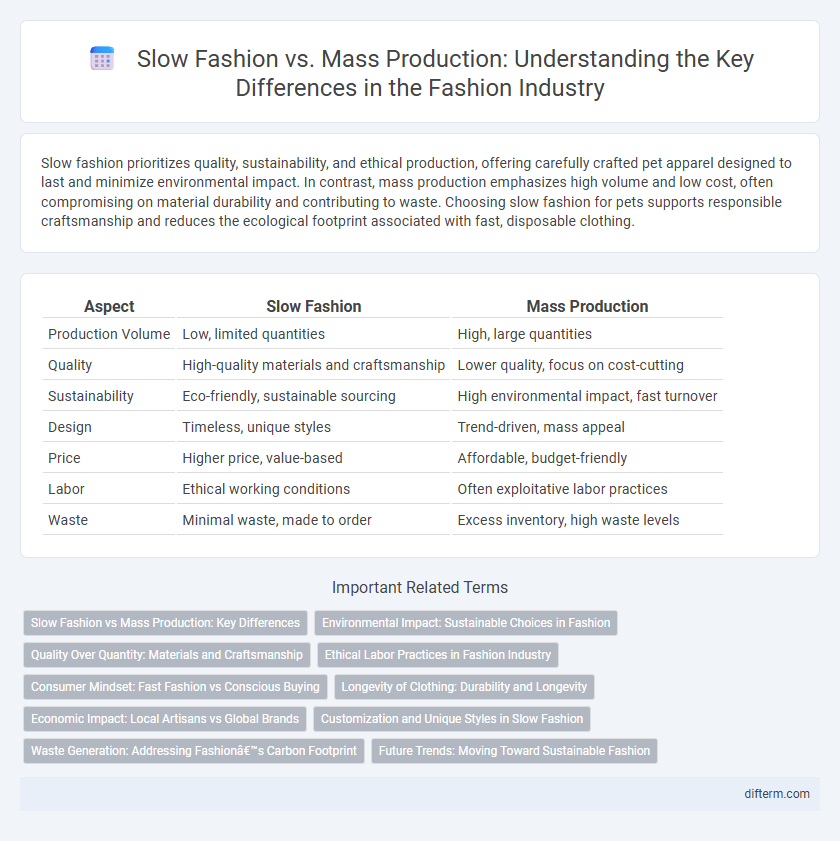Slow fashion prioritizes quality, sustainability, and ethical production, offering carefully crafted pet apparel designed to last and minimize environmental impact. In contrast, mass production emphasizes high volume and low cost, often compromising on material durability and contributing to waste. Choosing slow fashion for pets supports responsible craftsmanship and reduces the ecological footprint associated with fast, disposable clothing.
Table of Comparison
| Aspect | Slow Fashion | Mass Production |
|---|---|---|
| Production Volume | Low, limited quantities | High, large quantities |
| Quality | High-quality materials and craftsmanship | Lower quality, focus on cost-cutting |
| Sustainability | Eco-friendly, sustainable sourcing | High environmental impact, fast turnover |
| Design | Timeless, unique styles | Trend-driven, mass appeal |
| Price | Higher price, value-based | Affordable, budget-friendly |
| Labor | Ethical working conditions | Often exploitative labor practices |
| Waste | Minimal waste, made to order | Excess inventory, high waste levels |
Slow Fashion vs Mass Production: Key Differences
Slow fashion emphasizes sustainability, ethical labor practices, and high-quality, durable materials, contrasting sharply with mass production's focus on rapid turnover, cost efficiency, and disposable clothing. Key differences include slow fashion's limited batch sizes and localized production which reduces environmental impact, while mass production relies on large-scale factories and fast supply chains to maximize output. Consumers increasingly prefer slow fashion for its transparency and eco-friendly values, challenging the dominance of mass-produced fast fashion.
Environmental Impact: Sustainable Choices in Fashion
Slow fashion emphasizes environmentally friendly practices by using sustainable materials and minimizing waste, significantly reducing carbon footprints compared to mass production. Mass production relies heavily on synthetic fibers and fast turnover, leading to excessive water consumption, pollution, and landfill waste. Choosing slow fashion supports eco-conscious consumers seeking durability and ethical manufacturing, promoting long-term sustainability in the fashion industry.
Quality Over Quantity: Materials and Craftsmanship
Slow fashion emphasizes high-quality materials and meticulous craftsmanship, ensuring garments are durable and timeless, unlike mass production which often relies on cheaper fabrics and rapid assembly lines to maximize output. This focus on quality over quantity reduces waste and promotes sustainability by creating pieces designed for longevity rather than disposable trends. Consumers investing in slow fashion experience superior comfort and fit, reflecting the careful attention to detail and ethical sourcing practices.
Ethical Labor Practices in Fashion Industry
Slow fashion prioritizes ethical labor practices by ensuring fair wages, safe working conditions, and sustainable production methods, contrasting sharply with mass production that often exploits low-cost labor markets. Brands committed to slow fashion invest in transparency and worker rights, reducing environmental impact and promoting social responsibility throughout their supply chains. Ethical labor standards in slow fashion contribute to improved lives for garment workers and foster a more sustainable and humane industry overall.
Consumer Mindset: Fast Fashion vs Conscious Buying
Consumers driven by fast fashion prioritize affordability and rapid trends, leading to frequent purchases that fuel mass production and environmental degradation. In contrast, conscious buyers emphasize sustainability, quality, and ethical sourcing, seeking durable garments that reduce waste and support slow fashion practices. This shift in mindset promotes mindful consumption and encourages brands to adopt transparent, eco-friendly production methods.
Longevity of Clothing: Durability and Longevity
Slow fashion prioritizes durability and longevity by using high-quality materials and meticulous craftsmanship, resulting in garments that withstand extended use and multiple wash cycles. Mass production often relies on cheaper fabrics and rapid manufacturing processes, leading to lower garment durability and a shorter lifespan. Investing in slow fashion reduces textile waste and promotes sustainable consumption through long-lasting clothing.
Economic Impact: Local Artisans vs Global Brands
Slow fashion supports local artisans by preserving traditional craftsmanship and generating sustainable income within communities, fostering economic resilience. Mass production by global brands prioritizes high-volume output, often outsourcing labor to minimize costs, which can lead to job displacement and reduced local economic benefits. Investing in slow fashion stimulates small-scale economies and promotes ethical consumerism, contrasting with the profit-driven, centralized economic model of mass-produced fashion.
Customization and Unique Styles in Slow Fashion
Slow fashion emphasizes customization and unique styles by prioritizing handcrafted pieces and limited production runs, allowing consumers to express individuality. Unlike mass production, which relies on standardized, bulk manufacturing that often sacrifices personal uniqueness, slow fashion fosters sustainable practices through thoughtful design and quality materials. This approach supports artisans and promotes distinctive wardrobes that resist fast-fashion's disposable trends.
Waste Generation: Addressing Fashion’s Carbon Footprint
Slow fashion significantly reduces waste generation by emphasizing quality materials and timeless designs, resulting in fewer discarded items compared to mass production. Mass-produced fashion contributes heavily to the fashion industry's carbon footprint through excessive fabric waste and overproduction that often leads to landfill overflow. Embracing slow fashion practices mitigates environmental impact by promoting sustainable sourcing, recycling, and longer garment lifecycles.
Future Trends: Moving Toward Sustainable Fashion
Emerging future trends in fashion highlight a decisive shift from mass production to slow fashion, driven by increasing consumer demand for sustainability and ethical practices. Innovations in biodegradable materials, circular design, and localized manufacturing are set to reduce environmental impact while promoting transparency in the supply chain. These sustainable fashion movements prioritize quality, durability, and mindful consumption, challenging the traditional fast fashion model that dominates the industry.
slow fashion vs mass production Infographic

 difterm.com
difterm.com